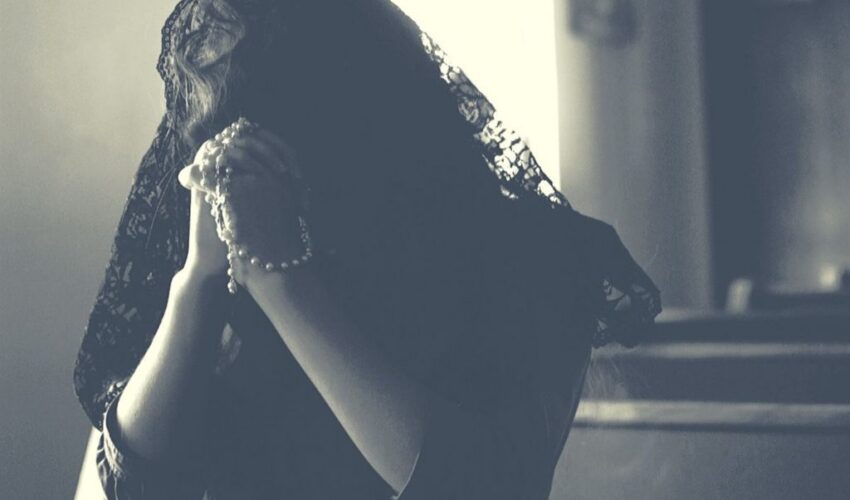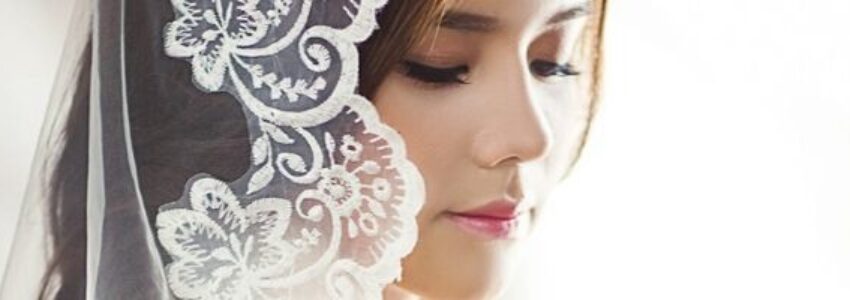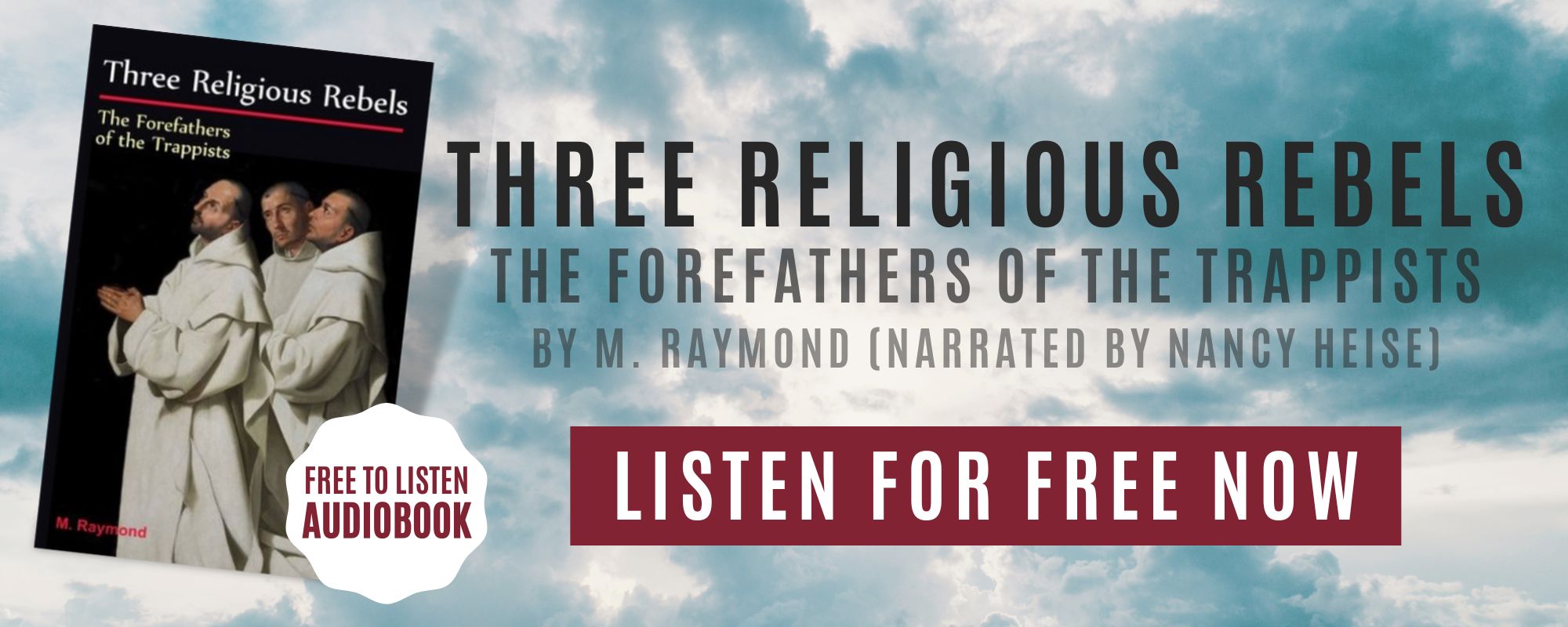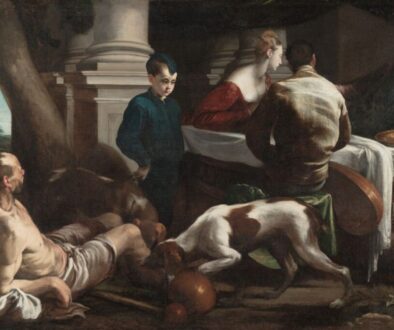The Meaning Behind Catholic Veils and How to Wear Them

Published August 4, 2023
The wearing of “mantilla” or chapel veil was a commonplace tradition for the first 2000 years of the Catholic Church. But for many decades, this beautiful tradition has seen a slow decline. Lately though, many millennial Catholics are readopting the practice.
So why do Catholics wear chapel veils?
Chapel veils had been a part of the Catholic identity. Catholic brides traditionally wear a veil while marching down the aisle. While traditional church attire often includes a lace mantilla. But aside from keeping with tradition, there are many reasons why many Catholics choose to wear mantilla veils when in church. In this post, we’ll discuss what these veils really mean for Catholics.
What is the Purpose of Veiling?
In the early Catholic tradition, veiling is a reminder of the spousal relationship between Christ and the Church. The Catholic veil is also a reminder of the sanctity and dignity of women. And wearing a chapel veil is a visualization of a woman’s submission to a man within their marriage.
But as the years went by, chapel veils slowly stopped becoming a symbol of women’s subservience to men. Instead, the Catholic chapel veil is now used to cover something that we consider sacred. Meaning, the veil’s purpose has now shifted from being a symbol of servility to protecting something that is cherished, respected, and adored.
If you notice, it’s not only the women being veiled. We Catholics also veil the altar and tabernacle that houses our Lord. The chalice, which contains our Lord’s blood, is also veiled. We put veils on things that we recognize as worth protecting because it is holy, and life flows from it.
Today, we consider the use of the veil not only a visible act of modesty and humility. But also as a sign of reverence and surrender to God’s will. Donning on chapel veils is a visual statement and a public proclamation before the Lord that He is the Lord and that we love Him, and that we are ready to obey him.
The Biblical Significance of Veiling
In his first letter to the Corinthians, St. Paul tells women the importance of wearing a head covering. He says,
And whereas any man who keeps his head covered when he prays or utters prophecy brings shame upon his head, a woman brings shame upon her head if she uncovers it to pray or prophesy; She is no better than the woman who has her head shaved. If a woman would go without a veil, why does she not cut her hair short too if she admits that a woman is disgraced when her hair is cut short or shaved, then let her go veiled…
… Judge for yourselves; Is it fitting that a woman should offer prayer to God unveiled? Does not nature itself teach you that, whereas it is a disgrace to a man to wear his hair long, when a woman grows her hair long, it is an added grace to her? That is because her hair has been given to her to take the place of a veil. (1 Corinthians 11:4-16)
This epistle inspired the practice of veiling for women in all of Christendom. Since then, it has become a tradition for women to wear some sort of head covering when going to church. In some Christian traditions, women even wear a traditional chapel veil even when not in church. This tradition also inspired medieval women’s attire as well as traditional costumes for women in predominantly Catholic countries.
Early Catholic women wear chapel veils primarily as a symbol of modesty. In those days, it was believed that keeping the head covered helped maintain a woman’s dignity.
Today, society’s standards for modesty have come a long way. A woman can still be considered respectable even if she doesn’t wear a veil or any head covering. But we can still see Catholic women willingly wearing the veil for various reasons.
Some women say that with a veil on, they feel more humbled and reverent. It’s just like when you’re removing a hat during a national anthem. While others share that it enables them to experience “authentic femininity,” as shown by the Blessed Virgin.

Why Veiling is Becoming Popular Again
One of the casualties of the ongoing cultural revolution among women is chapel veils. While the 1917 Code of Canon Law prescribes it, it wasn’t necessarily encouraged among the faithful. Thus, for the past few decades, veil mantillas have been worn mostly by older Catholic women. But now, many millennials are readopting the traditional chapel veils.
If you search the internet about chapel veils, you’ll notice an emergence of online stores selling them. There are also internet forums dedicated specially for those interested in the practice. One woman even commented that she feels more comfortable wearing a chapel veil mantilla because others are wearing it too. One Instagram influencer even regularly shares photos of herself in flawless makeup and wearing a lace mantilla.
As with most of the things they do, millennials wear veil mantillas mostly for personal reasons. Former America’s Next Top Model candidate Leah Darrow said that wearing a pretty veil fits her “girly-girl” persona. While a 24 year old woman from Ohio said that wearing a mantilla is her way of emulating the Virgin Mary. While some girls say that it coincides with their desire to wear a physical “habit” to show their Catholic identity.
Types of Veils Catholic Women Wear
Chapel veils come in all forms, sizes, and colors. But most of the time, they are made out of lace. The most common ones are:
- Circular Head Veil. As the name suggests, this chapel veil design is round and barely covers the head.
- Semi-circular Veil. This design is named such because it’s shaped like a circle that’s cut in half. It’s designed to be draped over the head but barely reaches the shoulder.
- Triangular Veil. Again, this type of veil got its name from its shape. It looks strikingly similar to a pañuelo – a type of Spanish neck scarf used during the 18th to 19th centuries. Because of its shape, it forms a more elegant drape over the shoulders and a slightly pointy end at the back.
- Infinity Veil. Unlike other types of veils, an infinity veil is connected on both ends, forming an infinite scarf. They are designed to be draped over the head, with the hems gathering artfully at the chest area.
- Wrap-around Veil. Wrap-around veils are typically much wider and longer than most types of veils since they are designed to be wrapped around the head and the shoulders.
There really is no standard when it comes to what type of veil you should wear. But certain colors are reserved for certain occasions. For example, a black veil is typically worn during funerals. So if you wear a black veil to church, it could look like you’re mourning. There are also online shops that let you customize mantilla veils. You can choose the lace, the color, as well as the hems depending on your personal preference.
What is the Ideal Length of a Chapel Veil?
In general, there is no universal standard in terms of a chapel veil’s length. The ideal length can vary depending on:
- personal preference
- religious tradition
- the specific context in which it will be used (wedding, mass, etc.)
Traditionally, chapel veils reach beyond the shoulders and covers a substantial portion of the hair. In some cases, they even extend to the mid-back or further down.
However, in the modern context, the length of your chapel veil largely depends on your personal style and preference. Some may prefer longer veils for a more traditional or conservative look, while others may opt for shorter veils for practicality or style.
If you’re still unsure, you can also consult with your church or religious community to see if they follow any specific veiling guidelines or customs.
How to Wear a Catholic Chapel Veil
The most important thing to remember when wearing a chapel veil is that it should placed correctly and securely on your head.
Catholic chapel veils are commonly placed on top of the crown of your head, cascading down the back. For added security, you may also use bobby pins or a headband to keep the veil in place. If using bobby pins, make sure they’re secure enough not to fall out during Mass.
Aside from putting it on, you should also be mindful of how you remove your veil. Take it off carefully by gently lifting the veil from your head so you don’t damage the fabric or pull out any of your hair with it.
Keep in mind that wearing a Catholic chapel veil is an act of devotion and should be handled with respect. Taking the time to ensure that your veil is placed and removed properly is not only a sign of respect for this tradition. It also shows your reverence and humility before God.
Parting Thoughts
For us Catholics, wearing a chapel veil is more than just a beautiful tradition that connects us to our faith. It also serves as a visible symbol of reverence and humility before God during worship.
Keep in mind, however, that chapel veiling is voluntary and just one way to express our devotion, among many others. It should never be used to judge or criticize our fellow Catholics. Whether you choose to wear a chapel veil or not, what matters is that our prayers should always come from the heart.
As we continue our spiritual journeys, let us be open to traditions that inspire and uplift us, all while remaining respectful and understanding of the diverse practices within our faith. May the chapel veil be a symbol of unity, devotion, and faith as we journey together in the love of Christ.
Seek a Deeper Connection with God and Join Lay Cistercians of South Florida
Lay Cistercians of South Florida, is a community of lay people who seeks to have a deeper connection with God by living a life inspired by the monks and nuns through Lay Monasticism. Learn more about what is a Lay Cistercian on our website. Anyone who aspires to do the same as us, and is a confirmed Catholic is welcome to join us! We meet every second Saturday of the month at Emmanuel Catholic Church in Delray Beach, Florida.

This Content Has Been Reviewed For Accuracy
This content has undergone comprehensive fact-checking by our dedicated team of experts. Discover additional information about the rigorous editorial standards we adhere to on our website.

About The Author
Judy Ponio is a professional writer for the Lay Cistercians blog and a devoted Catholic. She works hard to ensure her work uses accurate facts by cross checking reputable sources.




